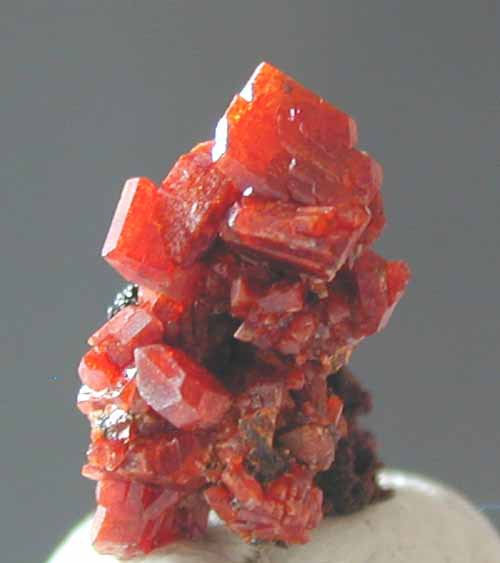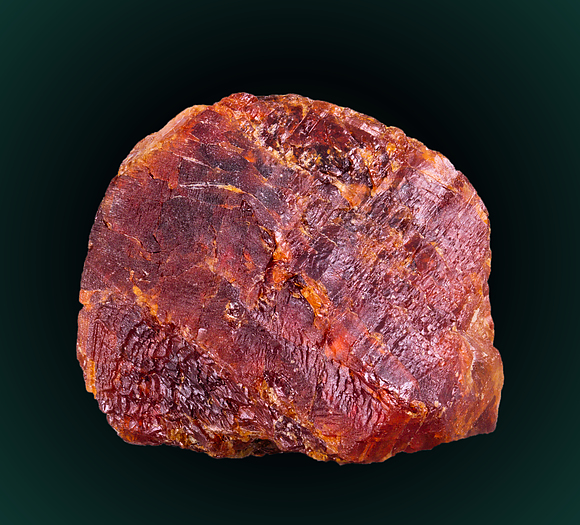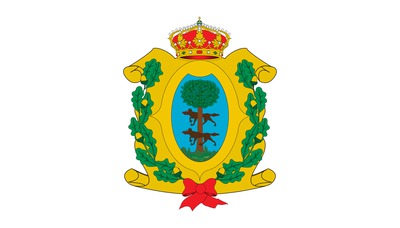Durangite
A valid IMA mineral species - grandfathered
This page is currently not sponsored. Click here to sponsor this page.
About Durangite
Formula:
NaAl(AsO4)F
Colour:
Light to dark orange-red, red; green; orange-yellow in artificial light.
Lustre:
Vitreous
Hardness:
5½
Specific Gravity:
3.94 - 4.07
Crystal System:
Monoclinic
Member of:
Name:
After the locality in the state of Durango, Mexico.
Type Locality:
Isostructural with:
Unique Identifiers
Mindat ID:
1332
Long-form identifier:
mindat:1:1:1332:7
GUID
(UUID V4):
(UUID V4):
181766bf-7d7b-49b9-b3a5-3e428f6229c8
IMA Classification of Durangite
Approved, 'Grandfathered' (first described prior to 1959)
First published:
1869
Classification of Durangite
8.BH.10
8 : PHOSPHATES, ARSENATES, VANADATES
B : Phosphates, etc., with additional anions, without H2O
H : With medium-sized and large cations, (OH,etc.):RO4 = 1:1
8 : PHOSPHATES, ARSENATES, VANADATES
B : Phosphates, etc., with additional anions, without H2O
H : With medium-sized and large cations, (OH,etc.):RO4 = 1:1
41.5.5.2
41 : ANHYDROUS PHOSPHATES, ETC.CONTAINING HYDROXYL OR HALOGEN
5 : (AB)2(XO4)Zq
41 : ANHYDROUS PHOSPHATES, ETC.CONTAINING HYDROXYL OR HALOGEN
5 : (AB)2(XO4)Zq
22.1.31
22 : Phosphates, Arsenates or Vanadates with other Anions
1 : Phosphates, arsenates or vanadates with fluoride
22 : Phosphates, Arsenates or Vanadates with other Anions
1 : Phosphates, arsenates or vanadates with fluoride
Mineral Symbols
As of 2021 there are now IMA–CNMNC approved mineral symbols (abbreviations) for each mineral species, useful for tables and diagrams.
| Symbol | Source | Reference |
|---|---|---|
| Dur | IMA–CNMNC | Warr, L.N. (2021). IMA–CNMNC approved mineral symbols. Mineralogical Magazine, 85(3), 291-320. doi:10.1180/mgm.2021.43 |
Pronunciation of Durangite
Pronunciation:
| Play | Recorded by | Country |
|---|---|---|
| Jolyon Ralph | United Kingdom |
Physical Properties of Durangite
Vitreous
Transparency:
Translucent
Colour:
Light to dark orange-red, red; green; orange-yellow in artificial light.
Comment:
Green colour exhibited by artificial material.
Streak:
Cream-yellow
Hardness:
5½ on Mohs scale
Tenacity:
Brittle
Cleavage:
Distinct/Good
On {110}, distinct.
On {110}, distinct.
Fracture:
Irregular/Uneven
Density:
3.94 - 4.07 g/cm3 (Measured) 3.616 g/cm3 (Calculated)
Comment:
Highest in dark-coloured, ferrian material.
Optical Data of Durangite
Type:
Biaxial (-)
RI values:
nα = 1.634 nβ = 1.673 nγ = 1.685
2V:
Measured: 45° , Calculated: 56°
Max Birefringence:
δ = 0.051

Image shows birefringence interference colour range (at 30µm thickness)
and does not take into account mineral colouration.
and does not take into account mineral colouration.
Surface Relief:
High
Dispersion:
strong
Pleochroism:
Visible
Comments:
X = ^c -25° = Orange-yellow
Y = Pale orange-yellow
Z = b = Nearly colourless
Y = Pale orange-yellow
Z = b = Nearly colourless
Chemistry of Durangite
Mindat Formula:
NaAl(AsO4)F
Crystallography of Durangite
Crystal System:
Monoclinic
Class (H-M):
2/m - Prismatic
Space Group:
B2/b
Setting:
C2/c
Cell Parameters:
a = 6.5789(5) Å, b = 8.5071(6) Å, c = 7.0212(5) Å
β = 115.447(4)°
β = 115.447(4)°
Ratio:
a:b:c = 0.773 : 1 : 0.825
Unit Cell V:
354.83 ų
Z:
4
Morphology:
Crystal habit is oblique pyramidal with {111} and {110} dominant. Faces commonly dull and rough. Artificial crystals are prismatic [101], and rarely tabular.
Twinning:
On {001} common as interopenetration twins (artificial crystals).
Crystal Structure
Load
Unit Cell | Unit Cell Packed
2x2x2 | 3x3x3 | 4x4x4
Unit Cell | Unit Cell Packed
2x2x2 | 3x3x3 | 4x4x4
Show
Big Balls | Small Balls | Just Balls | Spacefill
Polyhedra Off | Si Polyhedra | All Polyhedra
Remove metal-metal sticks
Big Balls | Small Balls | Just Balls | Spacefill
Polyhedra Off | Si Polyhedra | All Polyhedra
Remove metal-metal sticks
Display Options
Black Background | White Background
Perspective On | Perspective Off
2D | Stereo | Red-Blue | Red-Cyan
Black Background | White Background
Perspective On | Perspective Off
2D | Stereo | Red-Blue | Red-Cyan
View
CIF File Best | x | y | z | a | b | c
CIF File Best | x | y | z | a | b | c
Rotation
Stop | Start
Stop | Start
Labels
Console Off | On | Grey | Yellow
Console Off | On | Grey | Yellow
Data courtesy of the American Mineralogist Crystal Structure Database. Click on an AMCSD ID to view structure
| ID | Species | Reference | Link | Year | Locality | Pressure (GPa) | Temp (K) |
|---|---|---|---|---|---|---|---|
| 0019593 | Durangite | Downs G W, Yang B N, Thompson R M, Wenz M D, Andrade M B (2012) Redetermination of durangite, NaAl(AsO4)F Acta Crystallographica E68 i86-i87 |  | 2012 | the Barranca mine, Coneto de Comonfort, Durango, Mexico | 0 | 293 |
| 0010570 | Durangite | Kokkoros P (1938) Uber die struktur des durangit NaAlF[AsO4] Zeitschrift fur Kristallographie 99 38-49 |  | 1938 | Durango, Mexico | 0 | 293 |
CIF Raw Data - click here to close
X-Ray Powder Diffraction
Powder Diffraction Data:
| d-spacing | Intensity |
|---|---|
| 2.967 Å | (100) |
| 4.76 Å | (80) |
| 3.236 Å | (80) |
| 2.560 Å | (60) |
| 2.549 Å | (57) |
| 3.34 Å | (50) |
| 1.533 Å | (41) |
Geological Environment
Paragenetic Mode(s):
| Paragenetic Mode | Earliest Age (Ga) |
|---|---|
| Stage 4a: Earth’s earliest continental crust | >4.4-3.0 |
| 20 : Acidic volcanic rocks | |
| Stage 4b: Highly evolved igneous rocks | >3.0 |
| 34 : Complex granite pegmatites | |
| Stage 7: Great Oxidation Event | <2.4 |
| 45a : [Sulfates, arsenates, selenates, antimonates] | |
| 45b : [Other oxidized fumarolic minerals] |
Type Occurrence of Durangite
General Appearance of Type Material:
Rhombic orange-red crystals.
Place of Conservation of Type Material:
Yale University, New Haven, Connecticut, USA, 3.586, 3.3036, 3.3037.
Associated Minerals at Type Locality:
Reference:
Brush, G.J. (1869) On durangite, a fluo-arsenate from Durango in Mexico. American Journal of Science and Arts: 98: 179-182.
Other Language Names for Durangite
Relationship of Durangite to other Species
Member of:
Other Members of this group:
| Arsenatrotitanite | NaTi(AsO4)O | Mon. 2/m : B2/b |
| Isokite | CaMg(PO4)F | Mon. 2/m : B2/b |
| Kononovite | NaMg(SO4)F | Mon. 2/m : B2/b |
| Lacroixite | NaAl(PO4)F | Mon. 2/m : B2/b |
| Maxwellite | NaFe3+(AsO4)F | Mon. 2/m : P2/m |
| Panasqueiraite | CaMg(PO4)(OH,F) | Mon. |
| Reznitskyite | CaMg(VO4)F | Mon. 2/m : B2/b |
| Tilasite | CaMg(AsO4)F | Mon. |
| Tilasite-Isokite Series |
Forms a series with:
Common Associates
Associated Minerals Based on Photo Data:
Related Minerals - Strunz-mindat Grouping
| 8.BH. | Crimsonite | PbFe3+2(PO4)2(OH)2 |
| 8.BH. | Reznitskyite | CaMg(VO4)F |
| 8.BH. | Cuprozheshengite | Pb4CuZn2(AsO4)2(PO4)2(OH)2 |
| 8.BH. | Zheshengite | Pb4ZnZn2(AsO4)2(PO4)2(OH)2 |
| 8.BH. | Peterchinite | Zn3Zn2(OH)6As[O3(OH)3] |
| 8.BH.05 | Thadeuite | Ca(Mg,Fe2+)3(PO4)2(OH,F)2 |
| 8.BH.10 | Isokite | CaMg(PO4)F |
| 8.BH.10 | Lacroixite | NaAl(PO4)F |
| 8.BH.10 | Maxwellite | NaFe3+(AsO4)F |
| 8.BH.10 | Panasqueiraite | CaMg(PO4)(OH,F) |
| 8.BH.10 | Kononovite | NaMg(SO4)F |
| 8.BH.10 | Arsenatrotitanite | NaTi(AsO4)O |
| 8.BH.15 | Drugmanite | Pb2(Fe3+,Al)(PO4)(PO3OH)(OH)2 |
| 8.BH.20 | Bjarebyite | (Ba,Sr)(Mn2+,Fe2+,Mg)2Al2(PO4)3(OH)3 |
| 8.BH.20 | Cirrolite | Ca3Al2(PO4)3(OH)3 (?) |
| 8.BH.20 | Kulanite | Ba(Fe2+,Mn2+,Mg)2(Al,Fe3+)2(PO4)3(OH)3 |
| 8.BH.20 | Penikisite | Ba(Mg,Fe2+,Ca)2Al2(PO4)3(OH)3 |
| 8.BH.20 | Perloffite | Ba(Mn2+,Fe2+)2Fe3+2(PO4)3(OH)3 |
| 8.BH.20 | Johntomaite | BaFe2+2Fe3+2(PO4)3(OH)3 |
| 8.BH.20 | Bjarebyite Group | |
| 8.BH.20 | Strontioperloffite | SrMn2+2Fe3+2(PO4)3(OH)3 |
| 8.BH.20 | Plumboperloffite | PbMn2+2Fe3+2(PO4)3(OH)3 |
| 8.BH.25 | Bertossaite | (Li,Na)2(Ca,Fe2+,Mn2+)Al4(PO4)4(OH,F)4 |
| 8.BH.25 | Palermoite | (Li,Na)2(Sr,Ca)Al4(PO4)4(OH)4 |
| 8.BH.25 | Natropalermoite | Na2SrAl4(PO4)4(OH)4 |
| 8.BH.30 | Carminite | PbFe3+2(AsO4)2(OH)2 |
| 8.BH.30 | Sewardite | CaFe3+2(AsO4)2(OH)2 |
| 8.BH.35 | Adelite | CaMg(AsO4)(OH) |
| 8.BH.35 | Arsendescloizite | PbZn(AsO4)(OH) |
| 8.BH.35 | Austinite | CaZn(AsO4)(OH) |
| 8.BH.35 | Cobaltaustinite | CaCo(AsO4)(OH) |
| 8.BH.35 | Conichalcite | CaCu(AsO4)(OH) |
| 8.BH.35 | Duftite | PbCu(AsO4)(OH) |
| 8.BH.35 | Gabrielsonite | PbFe3+(As3+O3)O |
| 8.BH.35 | Nickelaustinite | CaNi(AsO4)(OH) |
| 8.BH.35 | Tangeite | CaCu(VO4)(OH) |
| 8.BH.35 | Duftite-alpha | PbCu(AsO4)(OH) |
| 8.BH.35 | Gottlobite | CaMg(VO4)(OH) |
| 8.BH.35 | Hermannroseite | CaCu(PO4)(OH) |
| 8.BH.40 | Čechite | PbFe2+(VO4)(OH) |
| 8.BH.40 | Descloizite | PbZn(VO4)(OH) |
| 8.BH.40 | Mottramite | PbCu(VO4)(OH) |
| 8.BH.40 | Pyrobelonite | PbMn2+(VO4)(OH) |
| 8.BH.40 | Khorixasite | (Bi0.67◻0.33)Cu(VO4)(OH) |
| 8.BH.45 | Bayldonite | PbCu3(AsO4)2(OH)2 |
| 8.BH.45 | Vésigniéite | BaCu3(VO4)2(OH)2 |
| 8.BH.50 | Paganoite | NiBi(AsO4)O |
| 8.BH.55 | Harrisonite | Ca(Fe2+,Mg)6(PO4)2(SiO4)2 |
| 8.BH.55 | Jagowerite | BaAl2(PO4)2(OH)2 |
| 8.BH.60 | Attakolite | CaMn2+Al4(SiO3OH)(PO4)3(OH)4 |
| 8.BH.65 | Leningradite | PbCu3(VO4)2Cl |
| 8.BH.70 | Katiarsite | KTiO(AsO4) |
| 8.BH.70 | Yurgensonite | K2SnTiO2(AsO4)2 |
| 8.BH.75 | Melanarsite | K3Cu7Fe3+O4(AsO4)4 |
| 8.BH.80 | Moraskoite | Na2Mg(PO4)F |
| 8.BH.80 | Evseevite | Na2Mg(AsO4)F |
| 8.BH.85 | Piccoliite | NaCaMn3+2(AsO4)2O(OH) |
Other Information
Notes:
Soluble in H2SO4.
Health Risks:
No information on health risks for this material has been entered into the database. You should always treat mineral specimens with care.
Internet Links for Durangite
mindat.org URL:
https://www.mindat.org/min-1332.html
Please feel free to link to this page.
Please feel free to link to this page.
Search Engines:
External Links:
Mineral Dealers:
References for Durangite
Reference List:
forum.amiminerals.it (n.d.) http://forum.amiminerals.it/viewtopic.php?f=5&t=18081&sid=7d8b1ed865c3dde7afc6276b9d04529f
Larsen, Esper S. (1921) The microscopic determination of the nonopaque minerals. Bulletin Vol. 679. US Geological Survey doi:10.3133/b679 p.70
Richmond, Wallace E. (1940) Crystal chemistry of the phosphates, arsenates and vanadates of the type A2XO4(Z) American Mineralogist, 25 (7) 441-479
Foord, E. E., Oakman, M. R., Maxwell, C. H. (1985) Durangite from the Black Range, New Mexico, and new data on durangite from Durango and Cornwall. The Canadian Mineralogist, 23 (2) 241-246
Downs, Gordon W., Yang, Betty N., Thompson, Richard M., Wenz, Michelle D., Andrade, Marcelo B. (2012) Redetermination of durangite, NaAl(AsO4)F. Acta Crystallographica Section E Structure Reports Online, 68 (11) 86-87 doi:10.1107/s160053681204384x
Localities for Durangite
Locality List
 - This locality has map coordinates listed.
- This locality has map coordinates listed.
 - This locality has estimated coordinates.
ⓘ - Click for references and further information on this occurrence.
? - Indicates mineral may be doubtful at this locality.
- This locality has estimated coordinates.
ⓘ - Click for references and further information on this occurrence.
? - Indicates mineral may be doubtful at this locality.
 - Good crystals or important locality for species.
- Good crystals or important locality for species.
 - World class for species or very significant.
(TL) - Type Locality for a valid mineral species.
(FRL) - First Recorded Locality for everything else (eg varieties).
- World class for species or very significant.
(TL) - Type Locality for a valid mineral species.
(FRL) - First Recorded Locality for everything else (eg varieties).
All localities listed without proper references should be considered as questionable.
Canada | |
| Foord et al. (1985) |
| Faribault (1908) | |
Mexico (TL) | |
| Brush G J (1869) +2 other references |
| Megaw (2023) |
Romania | |
| Hirtopanu et al. (2000) |
UK | |
| Embrey (1978) +1 other reference |
USA | |
| NMGS 37th Field Conference |
| NMGS 37th Field Conference |
| geoinfo.nmt.edu (n.d.) | |
| Northrop et al. (1996) | |
| Northrop et al. (1996) | |
| Mineralogical Record: 17 (5) |
| In the collection of Alex Earl |
Quick NavTopAbout DurangiteUnique IdentifiersIMA Classification Classification Mineral SymbolsPronunciation Physical Properties Optical Data Chemistry Crystallography Crystal StructureX-Ray Powder DiffractionGeological EnvironmentType Occurrence Other LanguagesRelationshipsCommon AssociatesStrunz-MindatOther InformationInternet Links References Localities Locality List






 symbol to view information about a locality.
The
symbol to view information about a locality.
The 



Barranca Mine, Coneto de Comonfort, Coneto de Comonfort Municipality, Durango, Mexico